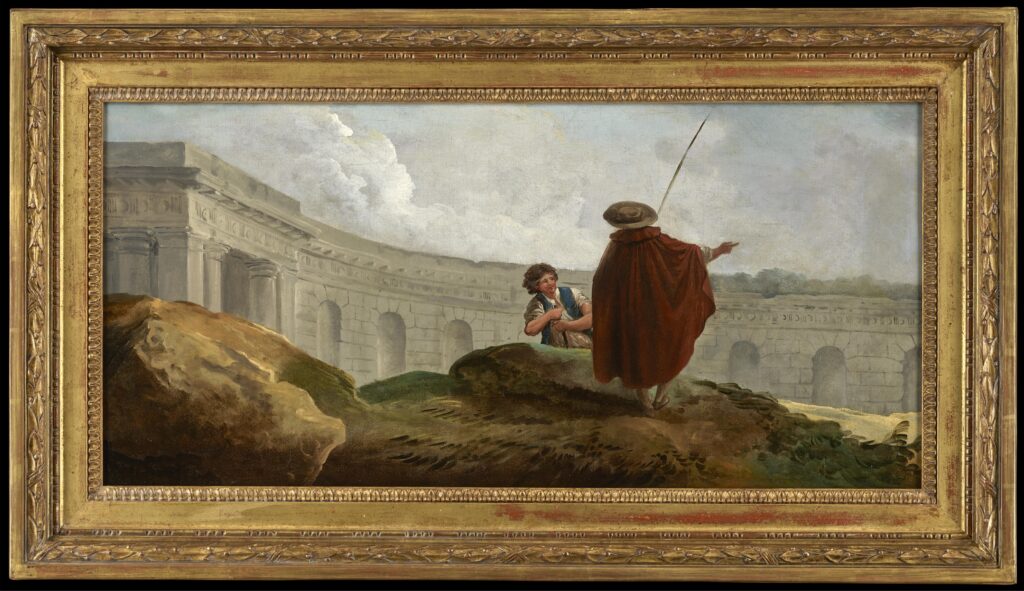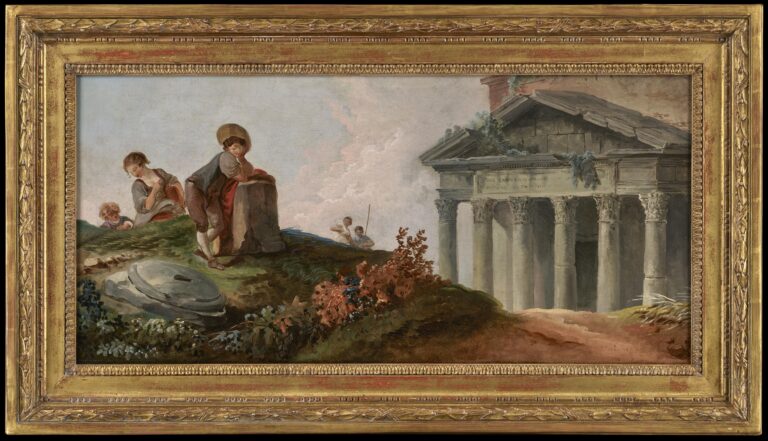Hubert Robert
1733 - 1808
Figures resting by archeological Ruins; a Classical Arcade beyond

Medium:
Oil on Canvas
Category:
Dimensions:
60(h) x 86.5(w) cms
Framed Dimensions:
59(h) x 103.5(w) cms
Paired with:
Essay:
A student of the sculptor Michel-Ange Slodtz, Hubert Robert travelled to Rome in 1754 in the retenue of the new French ambassador to the Vatican, the future Duc de Choiseul. It was probably through the influence of Choiseul that, although he was not officially a 'Personnaire' at the Academie de France in Rome, the young Robert was able to study there for several years. Succinctly described by the director of the Academie de France, Charles-Joseph Natoire, as a young man 'who has a taste for architecture' ('qui a le gout pour l'architecture'), Robert spent a total of eleven years in Italy, mostly in Rome. He fell under the particular influence of Giovanni Paolo Panini, the leading Italian painter of architectural views and 'capricci', who taught perspective at the French Academy, and Robert's earliest paintings and drawings, both in composition and technique, are greatly indebted to the example of Panini. Indeed, at the time of his death, Robert owned some twenty-five paintings by Panini, and in the preface to the 1809 sale catalogue of his collection it was noted that these were 'considered by Hubert Robert as the treasure of his studies: repeating daily that he owed to them, after Nature, the greatest part of his success'. At the Academie de France Robert met and befriended Jean-Honore Fragonard, and with him made sketching tours of the countryside around Rome. Both artists were also engaged by Jean-Pierre Richard, the Abbe de Saint-Non, to provide landscape illustrations for his projected 'Voyage pittoresque, ou description historique des royaumes de Naples, et de Sicile', eventually published in five volumes between 1781 and 1786.
Robert returned to Paris in 1765 and the following year was admitted into the Academie Royale as a 'peintre des ruines', rather unusually being both 'recu' and 'agree' in the same year. He made his debut at the Salon in 1767, exhibiting picturesque landscapes and capricci. He developed a particular reputation for his landscape paintings of real and imagined Roman views, often incorporating ancient ruins; so much so, in fact, that he was given the sobriquet 'Robert des Ruines'. A versatile artists, he often repeated and developed favourite views or compositions in several different formats, including chalk drawings, finished watercolours, small cabinet pictures and large-scale wall paintings. Appointed 'dessinateur des jardins du Roi' in 1778, Robert was also able to incorporate his artistic ideas into his landscape designs for gardens at Versailles and elsewhere. Despite being imprisoned during the Revolution, he remained a significant figure in the artistic scene in Paris until the end of the century.
-
This artwork and its companion piece was designed by Robert as ‘sopraporte’ – to be displayed as ‘overdoors’. These works were intended to be seen from a distance and from below. Robert heightens the illusion of this in each scene by tilting the perspective upwards; the ruins appear sunk behind the grassy banks on which the figures are seated. The vivid treatment of the foregrounded is placed in stark contrast with the muted colours of the mountainous landscape in the background, all contributing towards the trompe l’oeil effect.
Provenance:
Private Collection, Portugal
